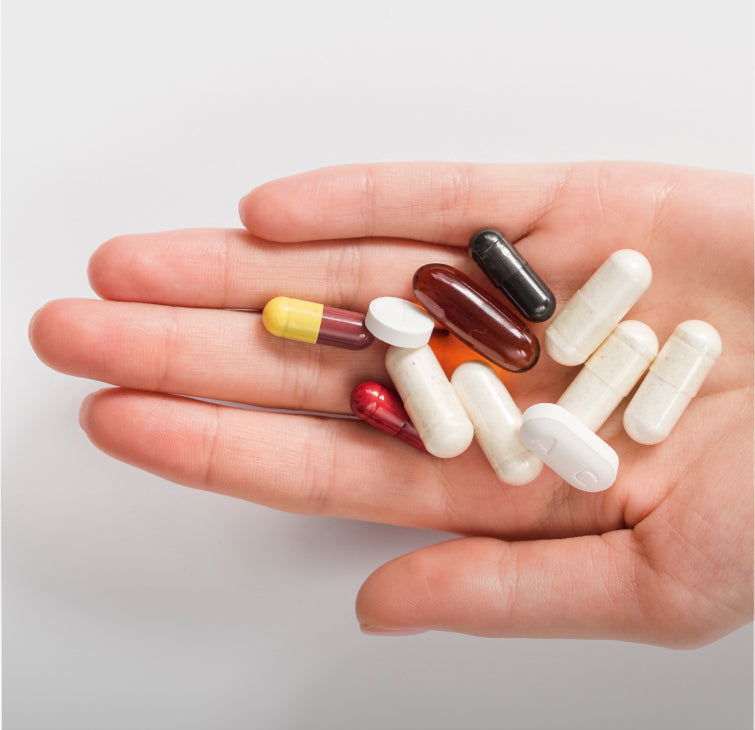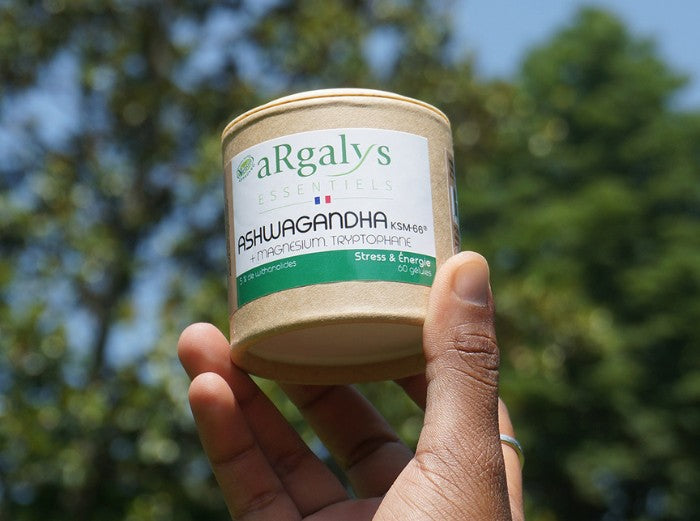Magnesium is a mineral essential for many biological functions. It is involved in energy production , muscle contraction , the transmission of nerve impulses and stress regulation (1). However, studies show that more than 70% of French people do not reach the recommended intake of magnesium , an alarming figure which may explain the frequency of disorders linked to its deficiency, such as fatigue, muscle cramps or irritability (2).
A balanced diet rich in magnesium is therefore essential to maintain our well-being and prevent deficiencies. But which foods are richest in magnesium? Are there plant-based sources that allow us to consume enough? How can we optimize its absorption to get the most benefits? In this article, we detail the best food sources of magnesium and strategies to improve its absorption.
The benefits of magnesium on the body
A key player in energy production
Magnesium is essential for cellular metabolism , playing a central role in the production of ATP (adenosine triphosphate) , the energy molecule essential to all cells in the human body (3). Without magnesium, ATP cannot be activated , which slows down all energy processes and can lead to chronic fatigue .
An essential mineral for the nervous and muscular system
Magnesium is directly involved in the transmission of nerve impulses , by regulating the activity of calcium channels. It thus helps to limit excessive neuronal excitation , often associated with stress and anxiety (4).
At the muscular level, magnesium helps relax muscles after a contraction , by opposing the action of calcium. A magnesium deficiency can cause cramps, muscle spasms and a feeling of permanent tension .
An ally for heart and bone health
Magnesium regulates blood pressure , promotes the dilation of blood vessels and helps maintain a stable heart rhythm (5). It is also essential for bone health , as it allows for good calcium fixation and thus limits the risk of osteoporosis .
The best food sources of magnesium
1. Oilseeds and seeds: the champions of magnesium
Almonds, cashews, hazelnuts, pumpkin seeds , and sunflower seeds are among the richest foods in magnesium . They also provide essential fatty acids , thus promoting magnesium absorption and the proper functioning of the cardiovascular system.
💡 Note: A 30g serving of almonds provides 80mg of magnesium , or nearly 20% of the recommended daily intake (6).
2. Whole grains: a good source of fiber and minerals
Whole grains like quinoa, brown rice, oats, and buckwheat are rich in magnesium, unlike refined grains. Refining can result in a loss of 80% of the magnesium in whole grains (7), which is why ultra-processed products are often lacking it.
3. Legumes: a plant-based alternative of choice
Lentils, chickpeas and kidney beans are excellent sources of magnesium. They are particularly good for vegetarians and vegans , as they also contain plant-based protein and fiber , which promotes good digestion and better blood sugar balance.
💡 Note: A 100g serving of cooked lentils provides approximately 36mg of magnesium (8).
4. Green leafy vegetables: rich in chlorophyll and magnesium
Spinach, kale, and Swiss chard owe their green color to chlorophyll , a molecule whose core is made of magnesium . This is why these vegetables are naturally rich in magnesium.
5. Why is dark chocolate a source of magnesium?
Dark chocolate (with more than 70% cocoa ) is an excellent source of magnesium , with about 200 mg per 100 g (9). This high content is explained by the natural presence of magnesium in the cocoa pod . In addition to magnesium, dark chocolate also provides antioxidants , which are beneficial for the cardiovascular system.
6. Mineral waters rich in magnesium: how can this be explained?
Some mineral waters contain significant amounts of magnesium due to the geological origin of the springs . Hépar or Rozana water, for example, is naturally rich in magnesium, as it comes from regions where volcanic rocks release this mineral into the groundwater (10).
💡 Please note: Rozana mineral water contains 160 mg of magnesium per liter , or nearly 40% of daily requirements .
7. Which fruits are richest in magnesium?
Although fruits are not the most concentrated sources of magnesium compared to oilseeds or whole grains, some of them have interesting levels, particularly when consumed regularly.
Among the fruits richest in magnesium, bananas are at the top, containing about 35 mg of magnesium per 100 g . Their high potassium and vitamin B6 content make them an excellent food for supporting muscle and nerve function. Dried figs are also a very good source, providing up to 65 mg of magnesium per 100 g , while dried prunes and raisins contain 40 mg and 30 mg per 100 g, respectively.
Raspberries, strawberries and kiwis should also be included in a varied diet, with levels around 15 to 20 mg per 100 g.
Daily magnesium requirements
Magnesium is a mineral essential for the proper functioning of the body, but it cannot be synthesized by the body and must therefore be provided daily through food. Recommended Dietary Intakes (RDI) vary depending on age, sex and specific physiological needs (11).
At the adults , the recommendations are 400 mg per day for men And 310 mg for women . Needs increase in pregnant and breastfeeding women , reaching 350 to 400 mg/day , to support fetal development and lactation. elderly people also have an increased need, due to decreased intestinal absorption and increased renal excretion of magnesium with age.
At the children , the recommended intakes change gradually with age:
- 1 to 3 years : 80 mg/day
- 4 to 8 years old : 130 mg/day
- 9 to 13 years old : 240 mg/day
- 14 to 18 years old : 360 to 410 mg/day depending on gender
THE sportsmen and the stressed people often require higher intakes, as excessive sweating and increased adrenaline release promote increased magnesium elimination (12). Similarly, certain digestive pathologies (such as Crohn's disease or malabsorption syndrome) and the use of certain medications (diuretics, proton pump inhibitors, metformin) can lead to decreased intestinal absorption and increased urinary losses, thus increasing requirements.
What are the risks of magnesium deficiency?
Magnesium deficiency can have repercussions on many physiological functions and cause various disorders, sometimes subtle at first, but which can worsen over time.
On the energy plan , a magnesium deficiency is often associated with chronic fatigue , because it is involved in the production of ATP, the main source of energy for cells. This drop in energy can manifest itself through a persistent feeling of tiredness, lack of concentration and increased irritability .
At the level muscular and nervous , magnesium deficiency promotes the appearance of cramps, muscle spasms (especially in the eyelids) and tingling . These symptoms are related to the effect of magnesium on the regulation of intracellular calcium, which is essential for the transmission of nerve impulses and muscle relaxation.
On the cardiovascular plan , a prolonged magnesium deficiency can lead to an increased risk of hypertension and heart rhythm disturbances (13). Indeed, magnesium acts as a natural vasodilator, helping to relax blood vessels and stabilize heart rate. A deficiency can also disrupt electrolyte balance, increasing the risk of arrhythmias.
Finally, a lack of magnesium is often associated with a deterioration of sleep quality , a increased stress , or even episodes of anxiety and mood disorders . Indeed, magnesium participates in the regulation of cortisol (stress hormone) and promotes the production of GABA, a neurotransmitter with relaxing effects (14).
If a balanced diet does not cover magnesium needs, supplementation can be considered to restore an optimal balance and prevent these risks.
🔎 Also read : Magnesium: how do you recognize a deficiency?
Choosing a magnesium supplement alongside your diet
When diet alone is not enough to cover needs, magnesium supplementation can be an effective solution. Among the most recommended forms, magnesium bisglycinate is particularly well absorbed by the body, unlike magnesium oxide, which has low bioavailability and a laxative effect (13).
Conclusion: Foods richest in magnesium
Magnesium is a fundamental element for the proper functioning of the body . By favoring a diet rich in foods naturally rich in magnesium , you optimize your overall well-being. However, if your needs are increased, a magnesium bisglycinate supplement can be an effective alternative.
Bibliography
1. Institute of Medicine (US) Panel on Micronutrients. Dietary Reference Intakes for Calcium, Phosphorus, Magnesium, Vitamin D, and Fluoride. National Academies Press (US), 1997.
2. Hercberg S, Galan P, Preziosi P et al. Dietary intake of minerals and trace elements in France: results of the SU.VI.MAX study. Nutrition and Dietetics Notebooks, 2005.
3. Romani AM. Cellular Magnesium Homeostasis. Arch Biochem Biophys. 2011;512(1):1-23.
4. Barbagallo M, Dominguez LJ. Magnesium and aging. Curr Pharm Des. 2010;16(7):832-839.
5. Kass L, Sullivan K, Schluter K et al. Magnesium intake and blood pressure: a meta-analysis of randomized clinical trials. Am J Hypertens. 2012;25(1):39-47.
6. USDA FoodData Central. Nutrient Data for Tree Nuts, Almonds, Raw. 2022.
7. Food and Agriculture Organization (FAO). Impact of food processing on the micronutrient content of foods. 2013.
8. Cianciosi D, Forbes-Hernandez TY, Quinzi D et al. Phenolic Compounds in Vegetables and Their Antioxidant and Anti-Inflammatory Properties. Int J Mol Sci. 2021;22(5):2025.
9. Shahidi F, Yeo J. Bioactivities of Phenolics by Focusing on Cocoa, Tea, Coffee, and Their Products: A Review. J Function Foods. 2018;45:188-199.
10. Azoulay A, Garzon P, Eisenberg MJ. Comparison of the Mineral Content of Tap Water and Bottled Waters. J Gen Intern Med. 2001;16(3):168-175.
11. EFSA Panel on Dietetic Products, Nutrition and Allergies (NDA). Scientific Opinion on Dietary Reference Values for magnesium. EFSA Journal. 2015;13(7):4186.
12. Nielsen FH. Magnesium deficiency and increased inflammation: current perspectives. J Inflamm Res. 2018;11:25-34.
13. Schwalfenberg GK, Genuis SJ. The Importance of Magnesium in Clinical Healthcare. Scientifica (Cairo). 2017;2017:4179326.
 04 74 03 98 80
04 74 03 98 80










